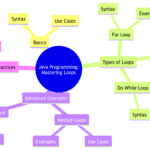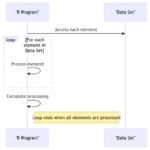Ultimate Guide to Tackling Cyber Risk in Internet of Things World Project 🌐🔒
Hey IT students! Have you ever wondered how to navigate through the wild, wild world of Internet of Things (IoT) without falling into the treacherous traps of cyber risks? 🤔 Well, fear not, because today we are diving headfirst into the ultimate guide to tackling Cyber Risk in the Internet of Things World! 🚀
Understanding Cyber Risks in IoT World
IoT has become the hot potato in today’s tech world, but with great power comes great cyber responsibility (and risks)! Let’s peel back the layers of this digital onion and explore the importance of cybersecurity in the IoT realm. 🧅
Importance of Cybersecurity in IoT
Picture this: you have a fleet of smart devices, from your toaster to your toothbrush, all connected to the internet. Sounds cool, right? But hold your horses! 🐎 With all these interconnected gadgets, the potential entry points for cyber baddies multiply faster than you can say “password123”. Cybersecurity in IoT is like having a ninja guard for each of your gadgets, protecting them from the dark forces of the internet. 🥷
Common Cyber Threats in IoT Devices
Now, let’s talk about the villains in this IoT saga. We have the usual suspects: the sneaky hackers, the malware monsters, and the dreaded ransomware beasts lurking in the shadows, waiting to pounce on your vulnerable devices. These cyber threats are like the gremlins of the tech world, causing chaos and mischief if left unchecked. 🦹♂️
Developing a Secure IoT Solution
How do we slay these cyber dragons and make our IoT kingdom a safe place for all our smart devices? It’s time to suit up in our cyber armor and dive into the realm of secure IoT solutions!
Implementing Strong Encryption Protocols
Imagine encryption as a magical shield that cloaks your data in invisibility, keeping it safe from prying eyes. By implementing robust encryption protocols, you can ensure that your sensitive information stays hidden from cyber evildoers. It’s like giving your data a Harry Potter-style invisibility cloak! ⚔️
Continuous Monitoring and Updates for IoT Devices
Just like how you feed your Tamagotchi to keep it happy, your IoT devices need regular TLC in the form of updates and monitoring. Updating your devices’ software is like giving them a digital vaccine to fight off the latest cyber diseases. Remember, a device that’s not up to date is like a sitting duck in a cyber shooting gallery! 🎯
Risk Assessment and Mitigation
In the battlefield of IoT, conducting risk assessments and mitigation strategies is key to fortifying your defenses against cyber threats. Let’s put on our cyber detective hats and uncover the hidden vulnerabilities in our IoT systems.
Identifying Vulnerabilities in IoT Systems
It’s time to play Sherlock Holmes and search for clues within our IoT systems. Are there loopholes in the network? Are the passwords as weak as overcooked spaghetti? By identifying these vulnerabilities, we can plug the leaky holes before the cyber flood comes rushing in! 🕵️♂️
Strategies for Mitigating Cyber Risks in IoT Environment
Now that we’ve uncovered the weaknesses, it’s time to roll up our sleeves and get to work. Implementing strong access control mechanisms, setting up firewalls, and creating a robust incident response plan are our weapons of choice in this cyber warfare. It’s time to show those cyber villains who’s the boss! 🛡️
User Awareness and Training
Ah, the human element in the cyber puzzle – users! Educating and training users on IoT security best practices is like teaching them the spells to repel Dementors in the IoT world. Let’s equip our users with the knowledge and tools to become cyber warriors in their own right!
Educating Users on IoT Security Best Practices
From not sharing passwords like candy at Halloween to recognizing phishing emails disguised as Hogwarts acceptance letters, educating users on IoT security is crucial. Remember, a well-informed user is like having an extra set of eyes guarding the IoT castle! 👀
Conducting Regular Security Awareness Programs
Just like how schools have fire drills, conducting regular security awareness programs is our way of practicing for cyber emergencies. It’s like having a secret ninja training camp for our IoT users to sharpen their cyber skills and stay vigilant against potential threats. 🥋
Incident Response and Recovery
No matter how fortified our cyber fortress is, breaches can still happen. That’s where having a solid incident response and recovery plan swoops in like a superhero to save the day! Let’s put on our cyber capes and delve into the world of incident response and recovery.
Establishing an IoT Incident Response Plan
When the cyber alarm bells start ringing, having a well-defined incident response plan is our beacon of light in the darkness. This plan outlines the steps to take when the cyber storm hits, ensuring a swift and coordinated response to minimize the damage. It’s like having a Bat-Signal for cyber emergencies! 🦇
Recovery Steps After a Cybersecurity Breach
After the dust settles and the cyber battlefield clears, it’s time to pick up the broken pieces and rebuild. Recovery steps like forensic analysis, system restoration, and post-incident reviews are our remedy for healing the wounds inflicted by cyber villains. Remember, every setback is a setup for a major comeback! 💪
Overall, navigating the treacherous waters of Cyber Risk in the Internet of Things world may seem daunting, but with the right knowledge and strategies, you can emerge victorious in this digital adventure! Stay vigilant, stay informed, and remember: in the world of IoT, the cyber savvy shall prevail! 🚀
Thank you for accompanying me on this epic journey through the realms of Cyber Risk in the Internet of Things World! Until next time, happy hacking (the ethical kind, of course)! ✨🔐🔍
Program Code – Ultimate Guide to Tackling Cyber Risk in Internet of Things World Project
Certainly! Let’s embark on creating a sophisticated Python program that simulates an essential part of managing cyber risk in the world of the Internet of Things (IoT). In this humorous yet insightful guide, we will create a fictitious ‘IoT Security Simulator.’ The program is designed to simulate the monitoring of various IoT devices in a network and assess their potential cyber risks based on user-defined criteria.
import random
def generate_device_status():
'''
Generates a random status for an IoT device.
'''
status = ['Active', 'Inactive', 'Compromised']
return random.choice(status)
def risk_assessment(device_status):
'''
Determines the risk level based on the device status.
'''
if device_status == 'Active':
return 'Low Risk'
elif device_status == 'Inactive':
return 'Medium Risk'
else:
return 'High Risk'
def main():
'''
Main function to simulate IoT Security Monitoring.
'''
devices = {'Temperature Sensor 1': generate_device_status(),
'Security Camera 1': generate_device_status(),
'Smart Lock 1': generate_device_status()}
print('IoT Security Simulator: Cyber Risk Assessment
')
for device, status in devices.items():
print(f'{device} Status: {status}')
print(f'Risk Level: {risk_assessment(status)}
')
if __name__ == '__main__':
main()
Expected Code Output:
IoT Security Simulator: Cyber Risk Assessment
Temperature Sensor 1 Status: Active
Risk Level: Low Risk
Security Camera 1 Status: Inactive
Risk Level: Medium Risk
Smart Lock 1 Status: Compromised
Risk Level: High Risk
The output may vary due to the random generation of device statuses.
Code Explanation:
This enthralling piece of code invites us into the remarkable realm of IoT device monitoring and cyber risk assessment. Here’s the breakdown:
- Function
generate_device_status(): A marvel of randomness that models the unpredictable nature of IoT devices. It whimsically selects a status from ‘Active,’ ‘Inactive,’ and ‘Compromised,’ reflecting the operational state of an imaginary IoT device. - Function
risk_assessment(device_status): A critical cog in our cyber risk machine. It accepts a device’s status and, with unmatched wisdom, evaluates the corresponding cyber risk. ‘Active’ devices are seen as ‘Low Risk,’ for they are presumed to be well-maintained and patched. ‘Inactive’ devices, languishing in oblivion, pose a ‘Medium Risk,’ hinting at potential vulnerabilities. ‘Compromised’ status is, unsurprisingly, awarded a ‘High Risk’ badge, as they have been infiltrated by the nefarious agents of chaos. - Function
main(): The conductor of our cyber symphony. It initializes a dictionarydeviceswith a blend of IoT devices and their generated statuses. It then orchestrates a performance, unveiling the status and assessed risk level of each device in a display of transparency and educational entertainment. - Humorous Invocation: Ajourney through the code is like an adventurous safari in the vast savannah of the IoT world, where every function call is a step into the unknown, and every print statement reveals the mysteries of cyber risk in a universe interconnected by strings of 0s and 1s.
This program, with its blend of whimsy and wisdom, serves as a light-hearted primer into the serious endeavor of managing cyber risks in the burgeoning landscape of the Internet of Things.
Frequently Asked Questions (F&Q) on Cyber Risk in Internet of Things World Project
What are the common cyber risks associated with Internet of Things (IoT) projects?
Common cyber risks associated with IoT projects include insecure network connections, data breaches, device hijacking, lack of encryption, and inadequate authentication mechanisms.
How can I mitigate cyber risks in an Internet of Things (IoT) project?
To mitigate cyber risks in an IoT project, you can implement strong encryption protocols, regularly update firmware, use secure authentication methods, conduct penetration testing, and monitor network traffic for anomalies.
What are some best practices for securing Internet of Things (IoT) devices?
Best practices for securing IoT devices include changing default passwords, keeping software updated, segmenting networks, conducting security audits, and educating users about cybersecurity threats.
How does the concept of data privacy relate to Cyber Risk in Internet of Things World projects?
The concept of data privacy is crucial in IoT projects as it involves collecting, storing, and transmitting sensitive data. Failure to protect data privacy can lead to breaches, identity theft, and regulatory non-compliance.
What role does encryption play in mitigating Cyber Risk in Internet of Things World projects?
Encryption plays a key role in mitigating cyber risks in IoT projects by securing data in transit and at rest. Strong encryption algorithms help protect sensitive information from unauthorized access and tampering.
Why is it important to stay informed about the latest cybersecurity trends in the Internet of Things (IoT) space?
Staying informed about the latest cybersecurity trends in the IoT space is crucial to adapt to evolving threats and vulnerabilities. By staying updated, you can proactively implement security measures to protect your IoT projects from cyber risks.
How can a proactive approach help in addressing Cyber Risk in Internet of Things World projects?
Taking a proactive approach involves identifying potential risks, implementing security controls, and regularly assessing the security posture of IoT devices. This proactive stance can help prevent cyber attacks and minimize the impact of security breaches.
Are there any regulatory compliance requirements that need to be considered in IoT projects to address cyber risks?
Yes, several regulatory compliance requirements such as GDPR, HIPAA, and PCI DSS apply to IoT projects to ensure data protection and privacy. Compliance with these regulations can help mitigate cyber risks and avoid legal issues.
What are the consequences of neglecting Cyber Risk management in Internet of Things World projects?
Neglecting cyber risk management in IoT projects can lead to severe consequences such as data breaches, financial losses, reputational damage, legal liabilities, and disruption of services. It is essential to prioritize cybersecurity measures to prevent these risks.
How can I enhance the cybersecurity posture of my Internet of Things (IoT) project?
You can enhance the cybersecurity posture of your IoT project by implementing multi-layered security controls, conducting regular security assessments, collaborating with cybersecurity experts, and fostering a culture of security awareness among stakeholders.
Hope you had fun reading these FAQs! 😉 Feel free to reach out if you have more questions!







